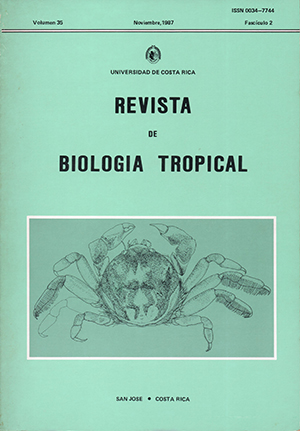Abstract
Some fig wasps (Agaonidae and Torymidae: Sycophaginae) and the mite Varroa jacobsoni exhibit analogous biological, morphological and behavioral characteristics that seem to have arisen through convergent evolution. Both groups develop in enclosed dark environments (small territories) with both high internal humidity and carbon dioxide concentration. The males of both groups are haploid, exhibit neoteny, and have shorter developmental phases and life spans than females. They do not fight at mating nor feed as adults. They are also less numerous and less sclerotized than the females. Male and female Varroa have enlarged peritremata and breathing tubes. Laminate breathing peritremal excrescenses or filaments are found in the Sycophaginae males (except Idarnes). The presence of large peritremata and protrudingbreathing structures, among other analogies between some fig wasps and the acarids, Varroa, seem to be adpatations to the humid environments in which they Jive during part of their life cycle.
Organisms that develop in closed microenvironments (seraglia) with very similar and constant physical, biological and feeding conditions, seem to have very constant ontogenesis and also develop specific one-to-one relationships; that is, each host has a specific associate (parasite or symbiont) . This type of association leads to radiative adaptations, synchronism of development for at least one of the associates and total dependence for at least one of the partners. They also show a high degree of relatedness.
Both Agaonidae and Varroa fit the "Local Mate Competition Rule" of Hamilton. Other characteristics that seem to fit into Hamilton's rule are: specific relationships between host and associate, developmental synchronization, associate females usually lay a constant number of eggs; nearly constant developmental time from egg to adult of the associate, neotenic males, very constant ontogenies of one of the associates and precise sex ratios.
References
Akratanakul, P. 1976. Biology and systematics of bee mites of the family Varroidae (Acarina: Mesostigmata). M.Sc. Thesis. Oregon Univ.: 64 p.
Barker, C.F. 1913. Astudy of caprification of Ficus nota Philipp. J. Sci. 8: 63-83.
De Jong, D. 1984. Current knowledge and open questions concerning reproduction in the honey bee mite Varroa jacobsoni. p. 547-552. In Advances in Invertebrate Reproduction 3, Elsevier Science Publishers, B.V.
Delfinado, M.D. 1974. Varroidae, a new family of mites on honey bees (Mesostigmata: Acarina). J. Wash. Acad. Sc. 64: 4-10.
Dreyfus, A. & M. E. Brever 1 944. Chromosome and sex determination in the parasitic hymenopteran Telerlonus fariari Lima. Genetics 29: 75-82.
Flechtmann, C.H.W. 1975. Elementos de Acarología. Livraria Nobel S.A. Sao Paulo. Brasil. 344 p.
Galil, J., M. Zeroni, & D. Bar Shalom. 1973. Carbon dioxide and ethylene effects in the coordination between the pollinator Blastophaga quadraticeps and the syconium in Ficus religiosa. New Phytol. 72: 1113-1127.
Galil, J. 1984. Anther dehiscense in fig syconia. p. 35-40 In Mini Symposium Figs and Fig Insects. Centre National de la Recherche Scientifique. France.
Green, R.F., G., Gordh & B.A. Hawkins 1982. Precise sex ratios in highly imbred parasitic wasps. Am. Nat. 120: 653-665.
Grobov, O.F. 1977. Varroasis in bees. p. 49-60 In Varroasis a honeybee disease: Bucharest, Apimondia Publishing House.
Hamilton, W.D. 1967. Extraodinary sex ratios. Science. 156: 47-488.
Hamilton, W.D. 1979. Wingless and fighting males in fig wasps and other insects, p. 168-220 In Reproduction, competition and selection of insects. M.S. Blum & N.A. Blum (eds.). New York: Academic Press.
Hilton, H.E. 1961. How some insects, especially the egg stages, avoid drowning when it rains. Proc. London Entomol. Nat. Hist. Soc.: 138-139.
Joseph, K.J. 1984. The reproductive strategies in fig wasps (Chalcidoidea: Hymenoptera). A Review. Proc. Indian Natn. Science B 50: 449-460.
Keeton, W.T. 1980. Biological Science. W.W. Norton and Co. New York and London, 3a. ed. 1080 p.
Langhe, A .B. & K. V. Natzkii. 1977. The mite Varroaa jacobsoni and the methods of controling it. p. 40-46. In Apimondia. Bucharest (op. cit.).
Mitchell, R. 1973. Growth and population dynamics of a spider mite (Tetranychus urticae K. Acarina: Tetranychidae). Ecology 54: 1349-1355.
Ramírez, B.W. 1977. A new classification of Ficus. Ann. Mo. Bot. Gdn. 64: 298-310.
Ramírez, B.W. 1986. The influence of the microenvironment (the interior of the syconium) in the coevolution between fig wasps (Agaonidae) and the figs (Ficus). p. 32 In Abstracts 6 th Int. Symp. Insect-Plant relationships. Pau. France.
Ramírez, B.W. & G.W. Otis. 1986. Developmental phases in the life cycle of Varroa jacobsoni, an ectoparasite mite on honeybees. Bee World 67: 92-97.
Smirnov, A.M. 1979. Acerca de la morfología e histología del ácaro Varroa jacobsoni. p. 3640 In Atajo y Prevención de la Varroasis. Bucharest, Apimondia Publishing House.
Valerio, C.E. 1974. Dimorfismo en avispas macho de la familia SceJionidae (Hymenoptera). Brenesia 3: 1-9.
Valerio, C.E. 1976. Significance of all-male progenies in some microhymenopteran parasites. Brenesia. 9: 25-29.
Wiebes, J.T. 1966. The structure of the ovipositing organs as a tribal character in the Indo-Australian sycophagine Torymidae (Hymenoptera). Chalcidoidea Zool. Med. 41: 151-159.
Wiebes, J.T. 1976. A short history of fig-wasps research. Gdn. Bull. Singapore 39: 207-224.
Wiebes, J .T. 1982. Fig. wasps (Hymenoptera). p. 735-755 In J.L. Gressit (ed.). Monographiae Biologicae. Williams, F. X. 1 928. Studies in tropical fig wasps, their bosts and associates. Bull. Hawaii Sug. Exp. Sta. Entomol. ser. 19: 1-179.
##plugins.facebook.comentarios##

This work is licensed under a Creative Commons Attribution 4.0 International License.
Copyright (c) 1987 Revista de Biología Tropical


